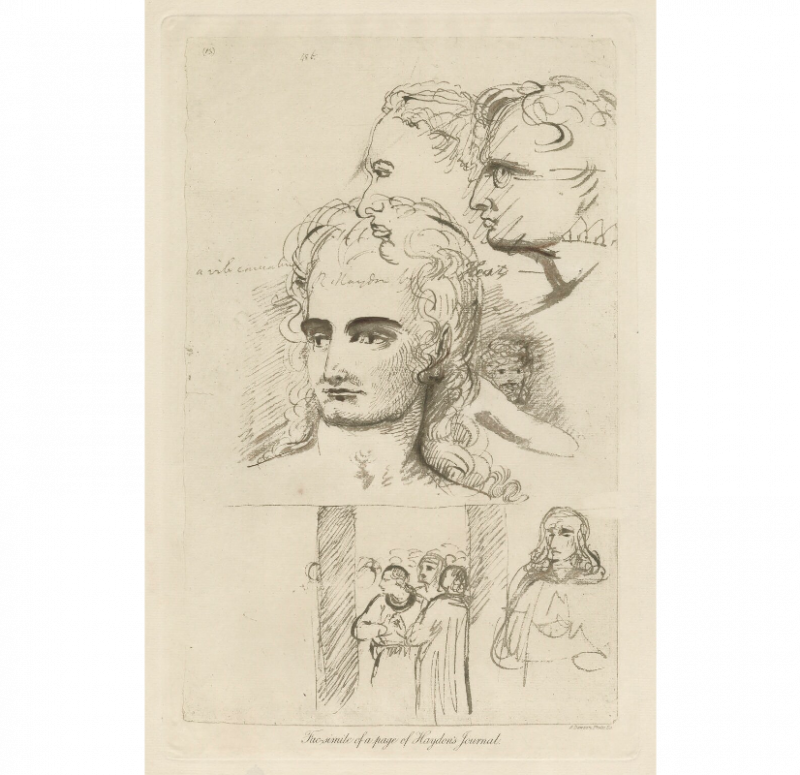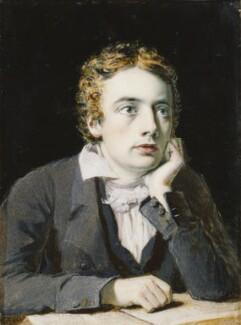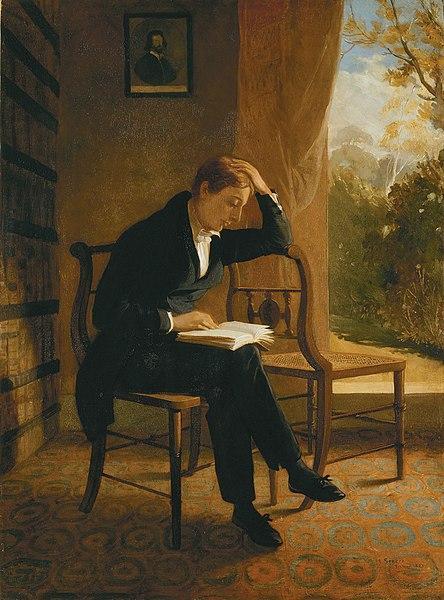Abstract
When the second-generation Romantic poet John Keats (1795-1821) – best known today for his ‘Great Odes’ and for coining the term ‘Negative Capability’ – died in Rome, at the age of 25, he may have been penniless, but he was certainly not friendless. Although his work received little public recognition during his lifetime, his close circle of friends in England strove to defend his genius and preserve his memory for posterity. Friendship was always central to Keats’s life; his poetry and letters attest to a vitally social existence, and to the lasting influence of London literary coteries on his development as a poet and thinker.
Keywords
‘The web of our Life is of mingled Yarn,’ writes John Keats (1795-1821), echoing his presiding genius, William Shakespeare, in an October 1817 letter to Benjamin Bailey which details the sometimes fraught relationships between members of the Hunt Circle.1 The statement, like the letter from which it arises, is characteristic of Keats – the second-generation Romantic poet best known for the astonishingly beautiful and innovative odes he composed in a flurry of creative activity in 1819, before his death at the unripe age of 25 – in that it entwines the literary and the social with empathetic alertness. It also highlights the extent to which Keats, far from the ethereal misfit his Victorian successors held him to be, saw himself as embedded in a variety of social networks, which pushed against the borders of his more narrowly defined socio-economic class: the letter begins by tracing his journey to Hampstead (‘where I found my brothers’), then to ‘Lambs Conduit Street’ (where he delivered a package to two other friends), before going on to visit the homes of Leigh Hunt and Benjamin Robert Haydon (now ‘jealous Neighbours’), where he also saw Percy Bysshe Shelley (I, 168-69). In chronicling such meetings, Keats’s letter weaves a tapestry of motley social experience, giving us a vibrant sense of the intellectual crosscurrents, as well as the private prejudices and tensions, which characterized London literary life in the Regency period.
Keats was not always known for such worldliness. Indeed, during his lifetime, and in the decades following his death, the poet’s name was hardly known at all, his readership limited to a handful of infamously harsh reviewers and to a more sympathetic circle of friends and admirers who cherished his memory and yet who could not help squabbling over how best to make his genius known to posterity. The publication, in 1848, of Richard Monckton Milnes’s Life, Letters, and Literary Remains, of John Keats, which brought together 66 poems and some 80 letters by the poet, along with a brief biography, was a crucial step in debunking the false image of Keats as a sickly, over-sensitive youth, whose unfitness for the world stemmed from a delicate constitution (an image partly indebted to Shelley’s 1821 elegy, Adonais). Yet, while insisting on his moral uprightness and the intellectually probing nature of his work, Milnes’s biography also reinforced the sense that Keats’s case was one of exceptional transcendence – transcendence of his lower-middle-class origins (his father, an ostler, had died in a riding accident when Keats was eight), but also of the coterie contexts which later critics would see as vital to his development as a poet and thinker.
- 1. The Letters of John Keats, 1814-1821, ed. Hyder E. Rollins, 2 vols. (Cambridge, MA: Harvard University Press, 1958), I, p. 169 (hereafter cited in text with reference to volume and page number). Leigh Hunt (1784-1859), co-founder of The Examiner, a radical weekly newspaper, and a leading literary figure in his own right, was the centre of the Hampstead-based circle frequented, in the first two decades of the nineteenth century, by such notable thinkers and artists as William Hazlitt, Percy Bysshe Shelley, Charles Lamb, Benjamin Robert Haydon, and John Hamilton Reynolds (all of whom Keats would befriend at social events organised at Hunt’s house).
Indeed, whereas most late-nineteenth- and early-twentieth-century readers treated Keats’s richly evocative poetry as having almost nothing to do with the social and historical conditions under which it was produced, biographers and critics in recent decades have made a determined effort to resituate the poet in the real world, reading him not only as a ‘poet’s poet’ – the fervent fashioner of extraordinarily fine phrases – but also as a man of his times, engaged in the pressing political issues of his day, and intent on putting ‘a Mite of help to the Liberal side of the Question’ (II, 180). This has meant not only retracing the poet’s footsteps with a microscopic attention to the places he visited and which often re-emerge, transformed, in his verse,2 but also combing through archival records to offer a more nuanced understanding of his early education at Enfield Academy and his subsequent medical training at Guy’s Hospital (where he would pass the qualifying examinations to become a licenced apothecary), while fleshing out the portrait of a ‘more vigorous, colourful and animated’ individual, a ‘smart, streetwise creature – restless, pugnacious, sexually adventurous.’3 As a result, it is impossible today not to read Keats’s work within a nexus of social contexts, and to see his poetry as both informed by and invested in the politically as well as aesthetically inflected notions of friendship and sociability circulating in literary coteries of the time.
From the start, Keats envisioned poetry as a fundamentally social undertaking, one whose raison d’être was melioristic, as it ‘should be a friend / To sooth the cares, and lift the thoughts of man’.4 Having abandoned a promising career in medicine for a less certain one in poetry, he redoubled his faith in the latter as a complementary means of alleviating suffering in the world. When it appeared in March 1817, Keats’s first published volume (simply entitled, Poems) bore witness, in various ways, to the importance he placed on sociability – not least of which, by beginning with a dedicatory sonnet to Hunt, whose commitment to ‘cheerfulness’ as a social and political value can be felt throughout the poems which follow. Many of these poems – which include a series of epistles and sonnets addressed to friends and family – signpost their own occasional and social nature, such as the sonnet ‘Written on the day that Mr. Leigh Hunt left Prison’, or the sonnet ‘On the Grasshopper and the Cricket’, which was the product of one of the friendly sonnet-writing contests held at Hunt’s house. One of Keats’s most famous early poems, ‘On first looking into Chapman’s Homer’, which first appeared in a December 1816 issue of The Examiner, celebrates one such instance of literary-social fellowship, transforming a shared reading experience – of a translation of Homer, which Keats had discovered with Charles Cowden Clarke, a friend from his schooldays – into a dazzling vision of individual as well as collective wonder. Other poems, such as ‘I stoop tip-toe upon a little hill’, invite the reader to partake, rather, in the sensuous enjoyment of open-air delights, from the ‘fresh woodland alley, never ending’ to ‘bowery clefts, and leafy shelves’ (ll. 20-21), as the speaker sets out, ‘light-hearted’ (l. 25), on a quest for pleasures natural and poetic.
- 4. From ‘Sleep and Poetry’ (ll. 246-47), in Keats’s Poetry and Prose, ed. Jeffrey N. Cox (New-York and London: W. W. Norton & Company, 2009), p. 64
If the poems of Keats’s 1817 volume explicitly attest to his formative experience in the Hunt Circle, and to the socially reformist principles nurtured therein, they can also be seen as paving the way for the two other volumes of poetry he would publish during his lifetime, and which bear the stamp of sociability in different, sometimes more troubled, ways. The first of these, the long romance poem, Endymion (published in spring 1818), turning to Greek mythology for inspiration, continued to draw on a Huntian vision of pastoral commonwealth and artistic communion (the poem famously begins, ‘A thing of beauty is a joy forever’), even as it set out to explore broader themes, such as the concomitant tensions between the real and the ideal, the past and the present, and human mortality and immortal art. These questions would be taken up again, with increasing complexity, in the poems of Keats’s third and final volume, Lamia, Isabella, The Eve of St. Agnes, and Other Poems (published in July 1820). Although, by the time he composed the ‘Great Odes’ and narrative poems grouped together in this volume, Keats had come to distance himself somewhat from Hunt and his circle – particularly in the wake of the notoriously hostile reviews directed at the ‘Cockney School of Poetry’, which appeared in Blackwood’s Edinburgh Magazine and The Quarterly Review in 1818 – the basic tenets of a meliorism founded in fellowship would continue to inform his writing in subtle ways.5 If these ‘late’ poems are inflected by self-scrutinizing irony and riddled with doubts – about the limits of the imagination, and the efficacy of poetry to assuage human suffering – they also give voice to a lasting belief in artistic creation as a means of transcending individual experience: for all of its frustrating ‘silence’ and pregnant inaccessibility, the ‘Grecian Urn’ of Keats’s best-known ode remains a ‘friend to man’, safeguarding, and continually adding to, the collective repository of ‘beauty’ and ‘truth’ available to all humankind.
- 5. On the question of Hunt’s lasting influence on Keats, see Jeffrey N. Cox, Poetry and Politics in the Cockney School: Keats, Shelley, Hunt and their Circle (Cambridge: Cambridge University Press, 1998).
Friendship was always at the core of Keats’s conception and practice of sociability.6 Nowhere do we see this more than in his letters, which, as one critic has suggested, were ‘in a sense written by the social life that went on around him.’7 In addition to showcasing the value he placed on individual friendships, Keats’s private correspondence sketches something like a secular system of salvation rooted, on the one hand, in a clear-eyed understanding of the transient nature of human existence, and, on the other hand, in willed acts of imaginative sympathy which allow for the overcoming of self-interest. ‘The more I know of Men,’ writes Keats, in a letter to his sister-in-law of January 1820, ‘the more I know how to value entire liberality in any of them. Thank God there are a great many who will sacrifice their worldly interest for a friend: I wish there were more who would sacrifice their passions’ (II, 243). Crucially, the letter form allows Keats to ruminate and digress, to test out ideas as he engages in an ongoing discussion which, pivoting on the creative axis of epistolary sociability, blossoms into broader reflections on the democratizing potential of friendly dialogue:
- 6. As Ronald Sharp writes, in an essay dedicated to the subject, ‘So fully did friendship pervade Keats’s life and work that it can have the dulling force of the obvious’ (‘Keats and Friendship,’ in Robert M. Ryan and Ronald A. Sharp (eds.), The Persistence of Poetry: Bicentennial Essays on Keats [Amherst: University of Massachusetts Press, 1998]), pp. 66-81, p. 67.
- 7. John Mee, ‘Introduction’, in John Mee (ed.), John Keats: Selected Letters (Oxford: Oxford University Press, 2002), pp. xiii-xxxiii, p. xiii [emphasis in orginial].
[…] the Minds of Mortals are so different and bent on such diverse Journeys that it may at first appear impossible for any common taste and fellowship to exist […]—It is however quite the contrary—Minds would leave each other in contrary directions, traverse each other in Numberless points, and [at] last greet each other at the Journeys end—A old Man and a child would talk together and the old Man be led on his Path, and the child left thinking—Man should not dispute or assert but whisper results to his neighbour, and thus by every germ of Spirit sucking the Sap from mould ethereal every human might become great, and Humanity instead of being a wide heath of Furse and Briars with here and there a remote Oak or Pine, would become a grand democracy of Forest Trees.8
Keats’s letters also reflect on the nature of the particular friendships they serve to renew. Indeed, his correspondence, as a whole, might be read as a cumulative effort to reinforce the ties at the heart of his social existence – those ‘Forest Trees’ of his own neighbourhood – beginning with his three siblings (with whom he found himself orphaned at the age of 14), and extending to an ever-ramifying network of dear friends. As he writes in another letter to John Hamilton Reynolds, of April 1818, ‘I could not live without the love of my friends’ (I, 267).
- 8. Letter to J. H. Reynolds of 19 February 1818 (I, p. 232).
The feeling was unsurprisingly mutual. As Fanny Brawne, Keats’s fiancée, would tell his younger sister: ‘I cannot tell you how much every one have exerted themselves for him, nor how much he is liked. […] I am certain he has some spell that attaches them to him, or else he has fortunately met with a set of friends that I did not believe could be found in the world.’9 After a pulmonary haemorrhage left him bedridden in February 1820, Keats was forced to stop writing poetry, and eventually to leave England for a more salubrious Mediterranean climate. The poet’s steadfast supporters – which included his publishers, John Taylor and James Hessey, as well as their legal adviser, Richard Woodhouse – banded together to secure the funds required for his trip to Rome. They also managed to secure a worthy travel companion in Joseph Severn, an ambitious Royal Academy painter who would be remembered as an eternal friend to Keats, giving him comfort in his painful last days, while ensuring the social bonds he valued most be maintained from abroad. In the journal-letters he sent back to England, which would be passed around and ‘interread’ (to borrow a Keatsian turn of phrase [II, 173]) amongst what is now known as the ‘Keats Circle’, Severn became ‘the lifeline of information to Keats’s friends, sending off detailed missives whenever he could. In ministering to Keats, he was also desperately trying to re-socialise him'.10
While his friends strove to keep him alive, Keats felt himself to be no longer ‘a Citizen of this world’ (II, 350) (a phrase which poignantly reverses his earlier evocation of participating in the growth of a ‘grand democracy of Forest Trees’). Slighted, ridiculed, or simply ignored by most of the reading public during his lifetime, he could nevertheless express, in the secure confines of private correspondence, a belief that he would be ‘among the English Poets after my death’ (I, 394), thus articulating a ‘posthumous existence’ in essentially sociable terms – envisioning himself not as a solitary bright star, hung aloft the night, but as part of a constellation of great minds contributing to the ‘grand march of intellect’ (I, 282) which would improve the lives of everyone. Even in his last extant letter, signing off with characteristic selflessness, Keats would give voice to the undying power of friendship: ‘I cannot bear the sight of any hand writing of a friend I love so much as I do you. […] I can scarcely bid you good bye even in a letter’ (II, 360).
Share
Further Reading
Hay, Daisy, Young Romantics: The Tangled Lives of English Poetry’s Greatest Generation (New York: Farrar, Strauss and Giroux, 2010).
Kandl, John, ‘The Politics of Keats’s Early Poetry,’ in Susan J. Wolfson (ed.), The Cambridge Companion to Keats (Cambridge: Cambridge University Press, 2001), p. 1-19.
Leadbetter, Gregory, ‘The Hunt Circle and the Cockney School,’ in Michael O’Neill (ed.), John Keats in Context (Cambridge: Cambridge University Press, 2017), p. 89-98.
Plumly, Stanley, The Immortal Evening: A Legendary Dinner with Keats, Wordsworth, and Lamb (New York and London: W. W. Norton & Company, 2014).
Rollins, Hyder E. (ed.), The Keats Circle: Letters and Papers, 1816-1878, 2 vols. (Cambridge, MA: Harvard University Press, 1948).


